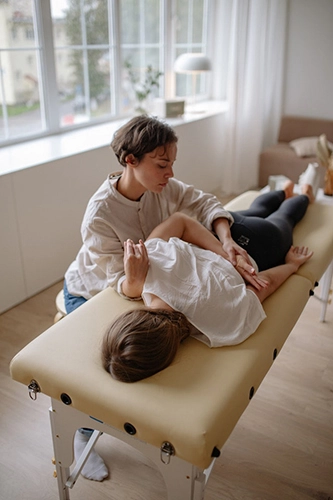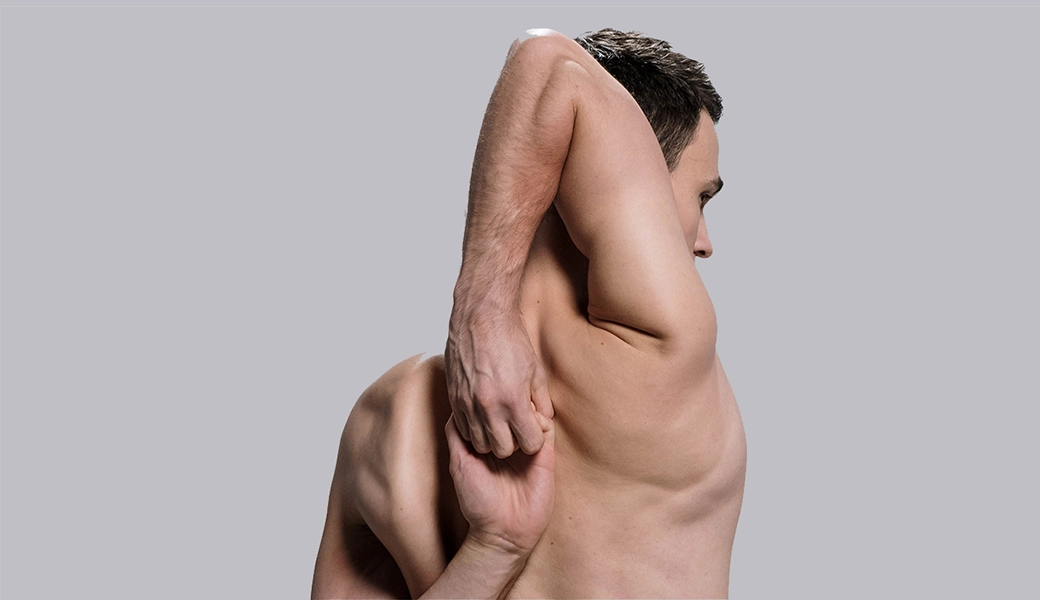Looking for relief from upper back spasms? Do you have a twinge in your back that just won’t quit? You’ve come to the right place. Your Anchorage-based chiropractor is here to help.
Spasms in the upper back can be annoying, painful, or even debilitating, depending on their severity. But there are a number of things you can do to give yourself upper back spasms relief. From simple ideas like the best sleeping position to specific therapeutic exercises, you’ll find a handy collection of tips below.
Anchorage Chiropractor Offers Natural Treatments for Upper Back Spasms
If you suffer from upper back spasms and you are looking for relief, don’t despair. There are a number of conservative, non-invasive techniques, treatments, and actions you can use or take. A common principle in chiropractic treatment is to try all conservative techniques before trying any heavy-duty treatments like surgery or prescription-strength painkillers.
Here is a compilation of just a few:
1) Practice Good Posture
One of the keys for preserving spinal health in general and preventing upper back spasms in particular is proper posture. If your spine is out of alignment, the muscles of your torso (both front and back) will try to compensate. The result is unnatural stretching and distortion of the muscles in question.
Good posture, though, will prevent that distortion. Practicing such posture until it becomes second nature should eventually provide you with relief from upper back spasms.
2) Sleep On Your Back
Sleeping position can be a critical factor when it comes to dealing with musculoskeletal issues. There are really just three primary sleep positions: sleeping on your back, sleeping on your side, or sleeping on your stomach.
Of those three, sleeping on your back is the best sleeping position for upper back pain and upper back spasm relief. It is even more effective when you place a pillow or cushion under your knees and, perhaps, a rolled-up towel under the small of your back. Basically, this preserves your spinal posture best and is more likely to keep you from developing upper back spasms.
Sleeping on your side is a close second. Again, a pillow placed between your knees will go a long way in keeping your spinal alignment healthy and preventing upper back spasms.
Sleeping on your stomach should be avoided, if possible. This position, more often than not, pushes your stomach into your spine distorting your back and posture. It’s just not good.
3) Choose the Best Pillow and Mattress
The type of pillow you choose (for your head) will likely depend on your sleeping position. The idea is to keep your head and neck in proper alignment with your spine. So, if you sleep on your back, you’ll want a thin pillow because that will keep your head from tilting out of alignment. If you sleep on your side, you’ll want a thicker one. If it’s too thin, your neck will bend down. If too thick, your neck will bend up. Both situations are undesirable.
As far as the mattress goes, you want a mattress that is firm enough to keep your spine in alignment. That means you want one that supports your rump and your shoulders. The particulars will vary according to the individual. Factors like body mass, height, and other things can influence this decision.
4) Strengthen The Back
Stronger muscles in the back translate into a spine less likely to fall out of alignment because of weak back muscles. To improve your posture, strengthen your back with exercise. Push-ups and face pulls are good option. The goal is a minimum of 30 minutes of exercise every day for five days a week. It will improve your health, your posture, and your back.
5) Try Massage
A massage is a great way to relax the body and reduce pain so that you can sleep more comfortably. And a good night’s sleep is always a plus. As for the massage, it can have the following benefits:
- It promotes the flow of blood thereby helping the body heal
- It lessens pain and tension in the muscles
- It promotes relaxation
- It can loosen constricted muscles that may be causing problems with your posture
Visit our Better Health Anchorage massage therapists to take advantage of our massage treatments highly recommended by thousands of Alaskans.
6) Try Your Local Anchorage Office of Chiropractic Care
Chiropractors are experts on the musculoskeletal system and the nervous system. They have a number of techniques and treatment options at their disposal. These include such things as spinal manipulation, adjustments, and a host of other chiropractic tools for muscle spasms and other musculoskeletal issues.
In the case of an upper back spasm, your local Anchorage chiropractor will likely, first, determine the cause of the spasm. If it’s from an injury, the chiropractor can recommend physical therapy. If it’s simply a case of bad posture creeping up on the patient, the chiropractor can use spinal manipulation treatments to correct the spinal misalignment. This can, in turn, correct posture and lead to the improvements mentioned above.
Other options in the chiropractor tool kit include:
- Physical Therapy
- Exercise
- Stretching
- Joint Adjustments
And more.
7) Try Physical Therapy and Physical Rehabilitation
An adjunct to chiropractic care is physical therapy. Combined together, these two types of treatment are far more effective than either one is alone. Physical therapy will likely consist of specialized exercises or the use of specialized modalities like:
- Ultrasound
- Cold-laser therapy
- Heat and Ice
- TENS device therapy
And more.
The above are some of the more frequently employed options used to battle upper back spasms. There are others. For a few more,you can check out this list of instant back pain relief tips.
8) Stretching Exercises
As noted above, sleep is a vulnerable time for your spine and back. The wrong pillow or wrong mattress or even just the wrong sleeping position can wreak havoc on your posture which, in turn, lead to back issues like upper back spasms.
Incorporating a regular stretching routine before you go to bed can not only reduce the impact of negative influences (if you can’t afford a new mattress, for example) but it can increase the benefits of your overall back spasm relief strategy.
Here are two stretches to include in your regimen:
- The Cobra: The Cobra is a stretch from the ancient Indian art of Yoga. It’s known for relieving tension – a huge plus for relieving back spasms.Begin by lying face down with your palms placed on the floor on either side of your shoulders. Push up your upper chest and torso while keeping your abdomen on the ground so that your spine curves slightly. Hold briefly, then release.
- The Upper Trapezius Stretch: The trapezius is a muscle in the upper back and neck. This stretch is used to relieve trapezius muscle knots and other issues in that area.Sit in a chair maintaining correct posture. Hold onto the chair with one hand, say, the left. While reaching over with the other hand (the right) to the opposite ear (left). Gentle pull your head in with your arm (to the right ear). Hold for a few seconds. Then repeat on the other side.
Other stretches include: Shoulder Shrugs, The Butterfly Stretch, The Doorway Stretch, and The Cat and Cow (this last is from Yoga).

Chiropractic Care and Upper Back Spasms Relief – The Science
Not sure that chiropractic care is your cup of tea? Unsure that it’ll help relieve your back spasms? Let’s take a quick look at some of the science on the subject.
The International Journal of Health Sciences and Research published a study in 2013 which found that the Myofascial Release Technique in conjunction with cold packs and exercise were an effective means of reducing muscle spasms in the upper trapezius (back and neck region).
A systematic review of scientific literature conducted by the Imperial Journal of Interdisciplinary Research in 2017 found that Text Neck Syndrome can be significantly helped with the implementation of postural correction.
Finally, a case study by De Gruyter involving a 29-year-old schizophrenic woman suffering from tardive dyskinesia (involuntary muscle contractions) along with neck and back pain was discussed. The study found that spinal manipulations helped reduce neck and back pain and improve the woman’s general quality of life.
As you can see, there is significant scientific evidence that upper back spasms can be treated and addressed by chiropractic care and similar types of treatment. Let’s dig a little deeper into the details.
Conclusion
As you can see, there are a number of simple, conservative techniques you can use to reduce, and sometimes even eliminate upper back spasms. As always, though, if it is a real medical issue you should contact your local Anchorage chiropractor or other medical professionals for assistance. Reading about exercises and such is one thing. Having someone who can demonstrate techniques or offer other treatments is quite another.
Sources:
https://www.degruyter.com/document/doi/10.7556/jaoa.2013.025/html










